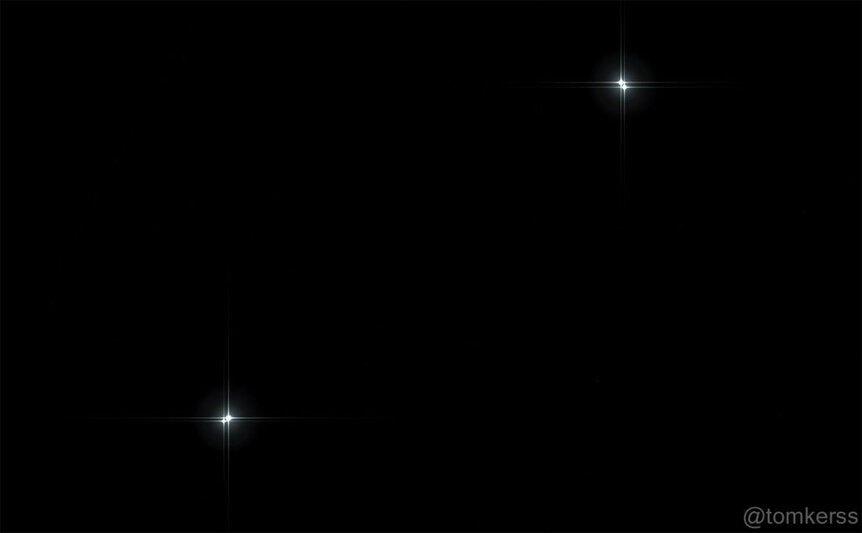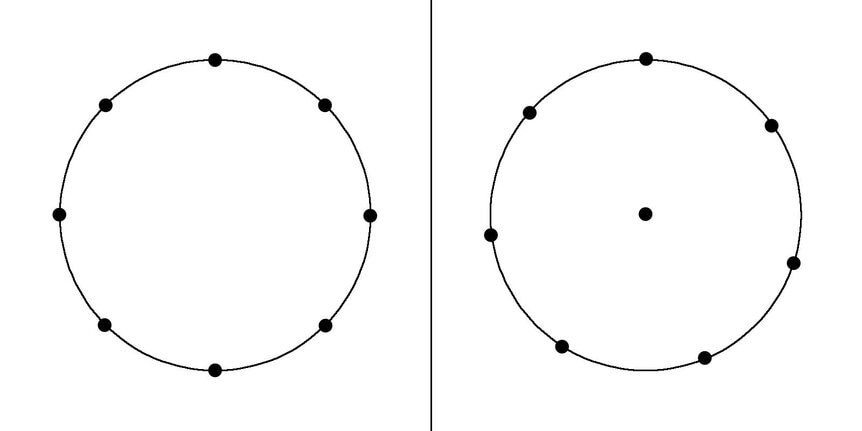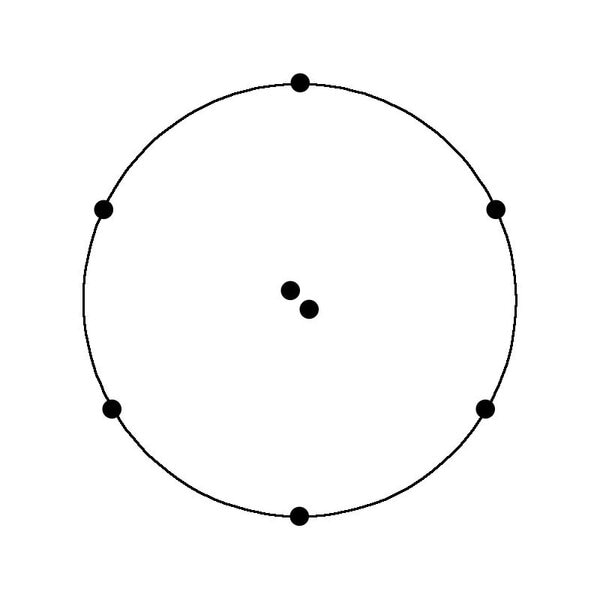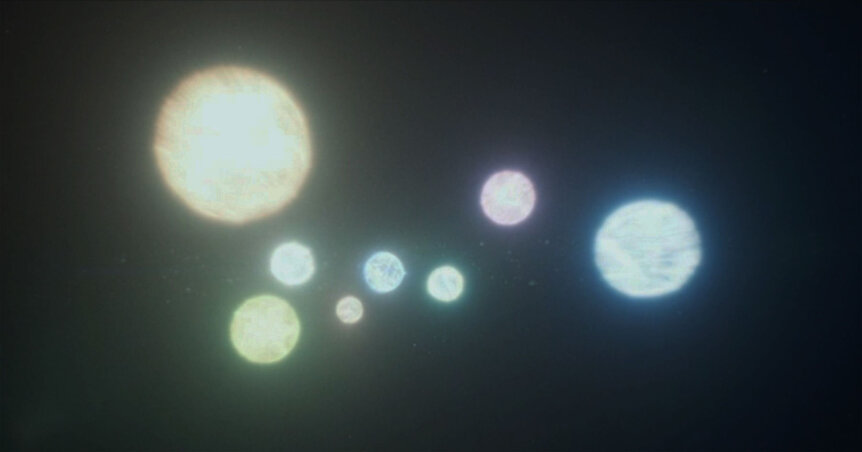Create a free profile to get unlimited access to exclusive videos, sweepstakes, and more!
Octonary stars and 'Broken Pieces': Can the eight-star system from Star Trek: Picard actually exist?

When we look out into the the final frontier, we suffer from an illusion imposed by distance: The stars look like single dots, points of light against the black.
But roughly half those stars are in fact multiple stars: binaries, trinaries, and even more stars orbiting around each other. From our vantage point of hundreds of trillions of kilometers away, perspective shrinks these systems down to a single point, like a distant car's headlights on a highway merging into one light.
This raises an interesting question: How many stars can you get orbiting each other in a stable pattern?
In the first season of Star Trek: Picard, a plot point revolves (so to speak) around a system of eight stars — an octonary, as it's called.
But… is such a thing even possible?
It turns out, yes, it is! In real life it'll be rare, but certainly plausible. In honor of the series' finale streaming today, let's go boldly and see how this works.
YELLOW ALERT: What follows has minor spoilers for Picard, starting around Episode 8, "Broken Pieces." Fairly warned be thee, says I (if I may mix franchises).
[Note: When I was about halfway through researching this article, I found out that my friend, astrophysicist, fellow science communicator, and Star Trek nerd Ethan Siegel wrote an article on this same topic for Forbes! However, my approach to it is a little different, so I suggest you read what he wrote first and then come back here for my take.]
So, an eight-star system. That would be complicated! We'd better take a step back and see how stars are born in the first place.
Stars form from clouds of gas and dust called nebulae. Star formation can be triggered in different ways, for example by a nearby star exploding and compressing the cloud, or two clouds collide. The cloud starts to collapse, and regions inside denser than average collect material, compress, flatten out into a disk, and heat up. At the center you get a star, and perhaps planets forming from the disk farther out.
But that happens only about half the time. If two clumps are close together, or a single clump collapses in an asymmetric way, you can get two stars forming in the center, revolving around each other: a binary star.
This can happen for higher multiplicities, too! Trinary stars are common, though less so than binaries. In fact the nearest star system, Alpha Centauri, is a trinary! Two stars orbit each other relatively closely, with a third, the red dwarf Proxima Centauri, orbiting the two.
But we can go further. One of my favorite stars in the sky is Epsilon Lyrae. By eye it looks like one star, but with a small telescope you can see two. However, under higher power each of those two stars is itself seen to be a binary! So two separate binary stars, each orbiting the other.
Even better: One of the stars in one of the binaries is itself an incredibly tight binary, making this a quintenary (five-star) system!
The bright star Castor in the constellation Gemini is a sextenary (six-star) system. And two septenary (seven-star) systems are known as well: Nu Scorpii and AR Cassiopeiae!
Now pay attention here: Nu Sco is composed of a binary orbited by a third star, with a fourth orbiting all three. Farther out is single star orbited by a binary, with all three orbiting the first four! AR Cas is similar, with a binary orbited by a single star close in, then a binary orbiting them, and a second binary farther out. Got it?
But… to the best of our knowledge, no octonary stars are known*.
Which brings us to the final frontier. In Episode 8 of the first seasons of Star Trek: Picard, Lt. Commander (retired) Raffi Musiker is tracking down something called the Conclave of Eight. Eventually she realizes it's an octonary star system.
At this point it should be clear that such a thing is possible. If we can have seven, then eight shouldn't be that much harder.
But, it'll be rare. A paper published in 2008 looked at relatively bright stars in the sky and examined their multiplicity. What they found is that out of 4559 stars, 2718 were solitary, 1437 were binary, 285 trinary, 86 quaternary, 20 quintenary, 11 sextenary, and 2 (Nu Sco and AR Cas) septenary. As you can see, increasingly complex systems are increasingly rare. But this survey was small; for each star in it there are tens of millions in the entire galaxy. So even rare things are bound to happen. As we see farther and with more clarity, I'd even bet we'll find them.
What about the octonary system shown in Picard? Happily, in the episode, Raffi shows a schematic of the system to Enoch, the navigational hologram. When I saw it, I laughed out loud in delight.
Why? Because the way it's depicted is not only plausible, it's the first thing I thought of!
Let's call the eight stars A though H. The way it's shown is as four sets of binaries. So the binaries are AB, CD, EF, and GH. But then the binaries AB and CD share an orbit, making a quaternary, and so do EF and GH. And these two four-star systems orbit each other, making eight. Woohoo!
This is a perfectly reasonable setup, and to my eye even looks like it could be stable.
Well, with two caveats. First, the scale is off. Imagine that, say, AB is more widely separated. As they orbit each other, A would pass close to CD while the B is on the other side of its orbit. That means the gravitational influence of CD is higher on A, yanking on it. That would change the shape of the orbit of AB, making it more elliptical. B would get yanked half an orbit later, elongating the orbit more. Eventually it would get so long the AB binary would destabilize and one star would likely get ejected. It could quickly disrupt the whole system!
As it happens, we know that "higher beings" placed those stars there hundreds of thousands of years ago, and wanted it to last for a long, long time.
To do this they'd have to make each pair tighter than shown (so each of AB, CD, EF, and GH), and the two sets of binaries (AB/CD and EF/GH) each a little wider, and furthermore the two pairs of four stars (ABCD and EFGH) farther apart. Then this could work!
The second caveat is more serious. The whole point of the octonary is to mark the location of a planet: Aia, the Grief World, where the advanced beings left a message called The Admonition. Forming a planet in such a system may not be impossible; we know that Proxima Centauri has a planet and that's a triple system, and we know lots of planets orbiting binaries (if the planet orbits both stars its called circumbinary, like Tatooine).
But the problem here is that Aia is supposed to be in the center of the eight stars. While a planet could be in the center, it's not stable there. It's like a ball sitting on top of a hill; a small push in any direction and away it goes. So in reality, that won't work.
There's another way the stars could be arranged, though: They could all share the same orbit in a ring! This is called a Klemperer Rosette, based on a paper published in 1962. You could have all 8 stars in the same orbit, spaced 360° / 8 = 45° apart, or you could put one in the center with the others spaced 360° / 7 = 51.4° apart. Both of these configurations work, but again they aren't stable; any small outside force on one of the stars and the whole thing falls apart.
A better way would be to have a tight binary in the center and then six stars spaced every 60°. This actually is a relatively stable configuration! The way the equations of gravity and motion work out, each star generates a small gravitational sweet spot 60° ahead and behind it in orbit where something placed there will tend to stay there. These are called Lagrangian Points.
The problem there is that the equations specify that the objects in orbit are much less massive than the one in the center. So, to fix that we make the binary in the center a couple of hefty stars 15 times the Sun's mass, say, then the other stars can be as massive as the Sun. Or you could put six dinky red dwarfs out there, which are much lower mass. I'm not picky.
Either way, you could then put the planet outside all the stars, making it a circumoctonary planet. It would have to be pretty far out to be stable, but that's OK because with eight stars all pouring put light and heat, being farther out is good idea anyway.
But the clues Raffi finds (and as the story comes right out and says) indicates the planet is in the center. That is something of an issue, because in the episode there's a scene where we approach the system, and all 8 stars fly past us, then an asteroid belt, and then the planet. That only works if the planet orbits all the stars well outside them! So the story itself is belied by the graphics they used in the show. Oops.
I can forgive that, though. And heck, we don't even have to worry too much about whether a system like can occur naturally anyway: As I said, those stars and the planet were placed into position by advanced beings! So worrying about the physics of this isn't critical, as far as the story goes.
Now, I'm not sure how you could move stars around using technology (maybe using a giant magnet to tow an electrically charged black hole around, using it as something like a winch to in turn move the stars around…?) but it would be terrifyingly advanced. Stars are rather big and massive. Getting eight of them to dance to your tune is… difficult. I mean, Q could snap his fingers and do something like this — he did, in the TNG episode "Deja Q" — but using physics as we know it, this would be a fierce undertaking.
But then, this advanced race started out as synthetic life, so they had a pretty decent head start on the tech needed.
As I write this article the final episode of the first season hasn't yet streamed, so I don't know how this will all work out. Maybe they all go to the octonary system and the synths receive the Admonition for themselves, and then get ascended (nuts, wrong franchise again), and travel the galaxy moving stars around and leaving vague warnings for other synths that drive organic life forms mad.
Maybe (probably) something else. Happily, a second season is already greenlit, so we'll get lots more Picard to enjoy. The galaxy is wondrous, with treasures to satiate desires both subtle and gross (if I may quote Q).
My appetite is more scientific. I expect I'll be satiated, too.
*Somewhat pedantically, I'll note that there are clusters of stars with hundreds, thousands, and even millions of stars in them. Heck, the Milky Way is a galaxy with 200 billion or so stars, and you could kinda sorta call that a star system. But here I think it's clear we're talking about smaller ones. I don't know where I'd draw the line, but it's somewhere between 8 stars and 200,000,000,000.




















